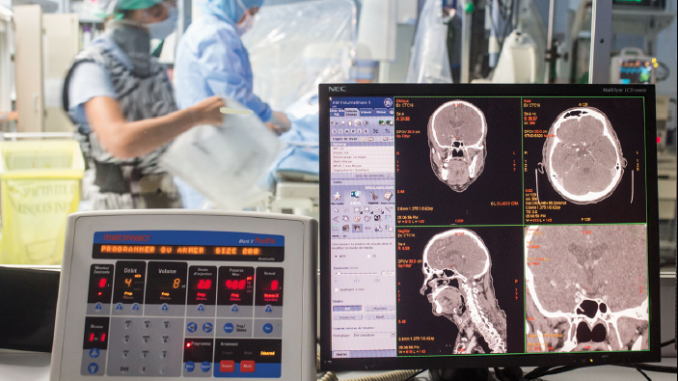 08 March 2016
(Last updated: 24 Jan 2020 17:13)
08 March 2016
(Last updated: 24 Jan 2020 17:13)
HERMES: messenger for stroke interventional treatment. The Lancet, February 18, 2016
Link to original article – http://dx.doi.org/10.1016/S0140-6736(16)00351-2
Quotes from tctmd article:
In an editorial accompanying the Lancet paper, Keith Muir, MD, of the University of Glasgow (Glasgow, Scotland), and Philip White, MD, of the University of Newcastle (Newcastle-upon-Tyne, England), said the NNT of 2.6 observed for the overall treatment effect “is extraordinary in itself and a huge advance in care for patients with stroke caused by occlusion of the major intracranial carotid territory vessels, who often respond poorly to optimal medical care with intravenous thrombolytic drugs and have high risk of mortality or disability.”
They note, however, that the results of these trials may not be broadly generalizable in routine practice. “Replicating the highly efficient networks of care in these trials, exemplified by the very short median time from symptom onset to intravenous thrombolysis of 100 min, will be a major challenge for many healthcare systems,” they write.
Muir and White also voice some caution about the interpretation of results from subgroups.
“In subgroup analyses, lack of statistical heterogeneity is not the same as evidence of efficacy when many major subgroups are so small; implementation of endovascular thrombectomy in circumstances such as late presentation, extensive early ischemic change on CT, or ineligibility for [IV tPA] should be done with caution, and ideally supported in due course by further trial evidence,” they argue.
Additional areas of uncertainty, they say, include the benefit of thrombectomy in more distal anterior circulation vessels and in the posterior circulation, whether general anesthesia or sedation is preferred, and the roles for aspiration techniques, balloon guiding catheters, adjunctive stenting of coexisting carotid stenosis, and additional intraarterial thrombolytic drugs.
“Nonetheless, the efficacy of endovascular thrombectomy in patients with anterior circulation stroke due to large artery occlusion is established, and implementation should be the priority,” they conclude. “Further trials are needed to clarify the boundaries of treatment.”
Link to tctmd (The Source for Interventional Cardiovascular News and Education) – Thrombectomy for Acute Stroke Works Across Subgroups, but Best When Done Early
Eyes on Evidence – Expert opinion on new evidence (NICE) October 2015
Intra-arterial treatment for acute ischaemic stroke
Download full article
Commentary by Phil White, Professor of Neurointerventional and Diagnostic Neuroradiology, Newcastle University and Honorary Consultant Neurointerventionist, Newcastle upon Tyne NHS Foundation Trust:
“The MR CLEAN trial has had a major impact worldwide on stroke research and clinical practice. Since this study was first reported, 5 ongoing trials of intra-arterial treatment reviewed their data and stopped early because a pre-specified end point had been reached (ESCAPE, EXTEND-IA, REVASCAT, SWIFT-PRIME and THRACE trials). These recent thrombectomy data are compelling, generalisable and robust. Although trials that stop early do tend to overestimate effect size, this caveat does not apply to MR CLEAN.
“What is most exciting and striking regarding thrombectomy is the consistency among trials in reporting a large clinical benefit despite different protocols, populations and imaging criteria for selection of participants. To improve outcome by 1 point on the modified Rankin scale, just 3 to 4 patients need to be treated within 6 hours, compared with more than 10 patients treated within 4.5 hours for intravenous thrombolysis (Brunström and Carlberg 2015).
“Typically in large-vessel occlusive stroke, less than 40% of patients treated with intravenous thrombolysis alone will be alive and independent at 90 days. However, with appropriate tissue-based imaging selection, intravenous thrombolysis combined with early thrombectomy increases the proportion of people alive and independent at 90 days to 61–71% (EXTEND-IA and SWIFT-PRIME).
Furthermore, the major advantage for thrombectomy is in reducing the proportion of people with severe disability after stroke, so the health economic advantage is likely to be greater still.
“Selecting participants on the basis of imaging findings was key to the positive results of MR CLEAN. Replicating these results in the NHS would mean at the very least obtaining vascular imaging (CT angiography) and systematically recording any changes on CT head imaging (via Alberta Stroke Program Early CT [ASPECTS] score) in all acute stroke patients potentially eligible for intra-arterial treatment. In addition, NHS stroke care services would need to be reconfigured for patients with large-vessel occlusive stroke to facilitate rapid access to thrombectomy that can be delivered within published standards of care.
“Although the findings of this study are positive, some uncertainties remain around how best to implement intra-arterial treatment – for example, whether to treat large-vessel occlusive stroke with thrombectomy on basis of CT or CT angiography findings alone, or whether to refine selection further with brain perfusion imaging.”